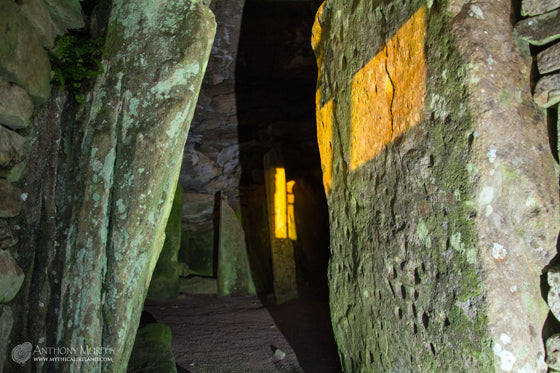
A glorious dawn announces the beginning of winter as sunrise shines into the chamber of Cairn L, Loughcrew
I hadn't been to Cairn L in a good few years, and to go there in the pre-dawn twilight, with Orion and Sirius looming above the ancient cairns was really something very special. But what was to follow was one of the highlights of many years of being present at ancient and sacred sites. The above video captures the essence of it, but of course nothing beats being there in person. At 7.44am, the sun appeared above the remains of a cairn on the summit of one of the Loughcrew Hills - known as Carrickbrack (from Irish carraig breac, meaning "speckled rock"), and also known as Sliabh Ruadh (Red Hill). One wonders just how ancient some of these place names really are.
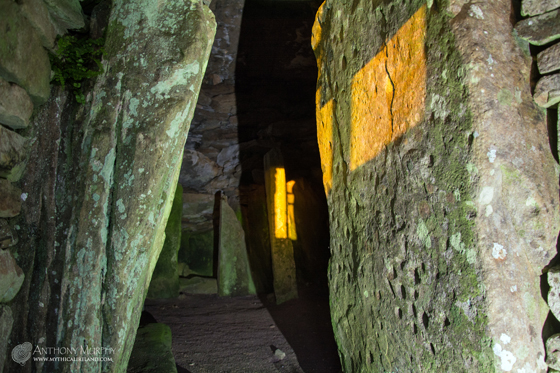 |
| Sunlight enters the passage of Cairn L and illuminates the limestone pillar in the chamber. |
As the sun appeared, its light immediately streamed into the passage and chamber of Cairn L, where it illuminated a limestone pillar in the chamber - a feature that is unique to Cairn L and not found in other ancient cairns with astronomical alignments.
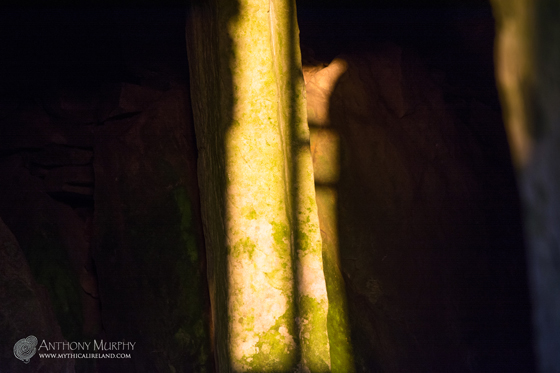 |
| The stone pillar in the chamber is lit up by the sun at dawn on Samhain and Imbolc. |
Martin Brennan and Jack Roberts and their team discovered this alignment in the early 1980s. It is one of many apparent alignments at Loughcrew. The most famous is the equinox alignment of Cairn T (the Hag's Cairn). Although I had been to Cairn L a couple of times, I had never been there at sunrise, and certainly not at Samhain! It was an immense pleasure, and a moment of pure joy and rapture to see the beautiful warm sunlight illuminating the interior of the cairn.
The significance of this event is that Samhain was a very important pre-Christian festival, possibly having its origins in prehistory. It was considered the beginning of winter, and as a so-called "cross-quarter" day, it marks the halfway point, measured in days, between the autumn equinox and the winter solstice. But unlike Newgrange, where the sun shines into its chamber around winter solstice, Cairn L will be illuminated twice - once in early November and again in early February, for the ancient festival of Imbolc, or the February cross-quarter day.
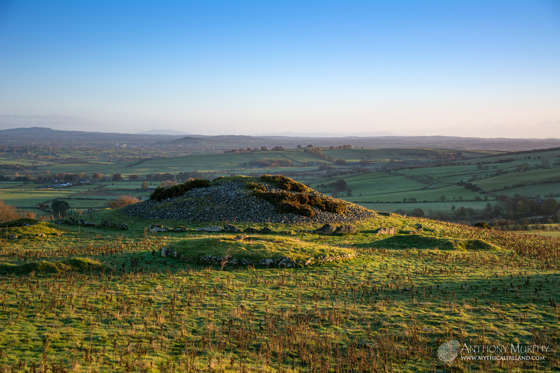 |
| The cairns at Loughcrew were said to have been dropped there by an ancient Cailleach or Garvoge. |
In local folklore, it is said that a hag (Cailleach) carrying an apron full of stones created the cairns as she jumped from hill to hill, dropping piles of stones as she did so. Another tale says the hills are sacred to the Garvoge, a "monster woman", who formerly lived here. The following is an old verse, sometimes attributed to Jonathan Swift, about Garvoge and Loughcrew:
Determined now her tomb to build,
Her ample skirt with stones she filled,
And dropped a heap on Carnmore,
Then stepped one thousand yards, to Loar,
And dropped another goodly heap;
And then with one prodigious leap
Gained Carnbeg, and on its height,
displayed the wonders of her might.
And when she approached death's awful doom,
Her chair was placed within the womb
Of hills whose tops with heather bloom.(1)
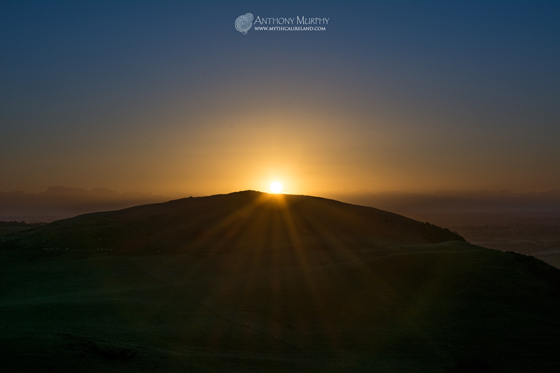 |
| The moment the sun rose from behind the summit of Carrickbrack. |
One cannot help, while looking out from Cairn L towards the other hills (Carnbane East, which was formerly better known as Sliabh na Caillighe; and Carrickbrack), both of which are topped with cairns, of the Paps of Anu or the Paps of Morrigan, and to see in the landscape the earth goddess herself. Perhaps, if one allows a little imagination, one can think of the breasts and the belly of that great woman, so venerated in ancient Ireland, as the earth itself, topped with these cairns that are attributed to her as miraculous works. Ancient though she may be, the Cailleach will never be forgotten at Loughcrew, because the Cailleach IS Loughcrew.
References:
(1) Conwell, Eugene Alfred, On Ancient Sepulchral Cairns on the Loughcrew Hills, Proceedings of the Roal Irish Academy (1836-1869), Vol. 9 (1864-1866), p. 358.
Special thanks to Lar Dooley and Ken Williams whose company was greatly appreciated. And to the landowner for allowing us access.

